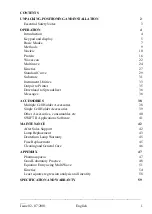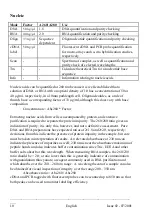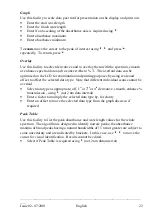
________________________________________________________________
___
Issue 02 - 07/2001
English
11
Background correction at a wavelength totally separate from the nucleic acid and
protein peaks at 260 and 280 nm, respectively, is sometimes used to compensate for
the effects of background absorbance. The wavelength used is 320 nm and it can
allow for the effects of turbidity, high absorbance buffer solution and the use of
reduced aperture cells. If your laboratory has not used background correction
before, set this option to no. It should be used with UViMicro disposable cells.
Concentration = (Abs260 – Abs320) * Factor
Absorbance ratio = (Abs260 – Abs 320) / (Abs280 – Abs 320)
The spectrophotometer calculates concentration, displays 260/280 ratio and
compensates for sample dilution. If you wish to use other wavelengths, for example
if the peak maximum is at 257 nm or a background correction of 350 nm, use nucleic
scan or absorbance ratio modes.
Use of 7 µl volume ultramicrovolume cell
•
If using this cell, please note that it has a 5 mm pathlength, and that these modes
assume a 10 mm pathlength cell is used.
•
Ensure the cell is filled correctly by holding up to the light using the viewer
supplied with the cell; this is to avoid the possibility of the liquid meniscus
being in the light beam and causing non-reproducible results.
•
Background compensation at 320 nm is useful when using restricted aperture
cells such as this
DNA, RNA, Oligo
•
Select if background correction at 320 nm is required using
4
•
Enter the sample dilution factor
•
If oligo
•
Enter the conversion factor if known, default is 33 µg/ml. The factor can be
calculated from a known base sequence if the concentration is known (see
Tm Calculation).
•
Enter the integration time using
4
•
Default is 1 second, other options are 2, 5 and 0.1 seconds. Use long
integration times for very low and very high absorbance readings.
•
Save method if required using
4
•
Insert reference and samples, and press
run
•
If using a single cell holder
•
Insert reference and press
set ref
.
•
Insert sample and press
run
(repeat as required)













































